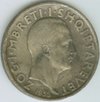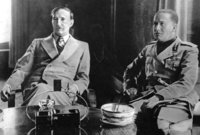Zog of Albania
|
|
Kingzog.jpg
His Majesty King Zog,(full ruling name Zog I. Skanderbeg III.) born Ahmed Bey Zogu (October 8, 1895–April 9, 1961), was an Albanian prime minister (1922-1924), president (1925-1928), and king (1928-1939 and 1943-1946, the latter period in name only).
| Contents |
Background and early political career
Ahmed Zogu was born in Castle Burgajet, Albania to Xhemal Pasha Zogu and Sadijé Toptani. He was a member of the royal house of Skanderbeg, which, by the time of his birth, was a feudal beylik family ruling over the city of Mati. As a young man during the First World War, Zog supported the cause of Austria-Hungary, counter to Albanian tradition which had tended to align with Eastern Europe or the Ottoman Turks.
In 1911, on the death of his father, Zog became Hereditary Governor of Mati and Chief of the Gheg clan. He was only sixteen at the time. He was detained at Vienna 1917-1918 and in Rome 1918-1919, before returning to Albania in 1919.
Zog held ministerial posts in the fledgling Albanian government that had been created in 1920. His political support included southern feudal landowners called beys (Turkish for "village chieftain") and noble families in the north, along with merchants, industrialists and intellectuals. Zog became leader of a major reformist party and later a prime minister of the republican government. In 1923, he was shot and wounded in parliament. His primary rivals were Luigj Gurakuqi and Fan S. Noli.
Zog held the post of Minister for the Interior March to November 1920, 1921-1924 and 1925, Minister for War in 1925, and General and Commander-in-Chief of the Albanian forces from 1921-1922. He also served as Governor of Shkodėr from 1920 to 1921.
A leftist revolt led by Noli forced Zog into exile in June 1924. He returned to Albania with the assistance of Yugoslavia-based White Russian troops.
Albanian president
Zog was officially elected to the post of president of the newly proclaimed Albanian republic by the Constituent Assembly on January 21, 1925, taking office on February 1. Zog's government followed the European model, though large parts of Albania still maintained a social structure unchanged from the days of Ottoman rule, and most villages were serf plantations run by the beys. A Muslim himself, Zog's reforms included the prohibition of veils and prohibitions against cruelty to animals. Zog's principal ally during this period was Italy, which loaned his government funds in exchange for a greater role in Albania's fiscal policy. During Zog's presidency, serfdom was gradually eliminated, and Albania began to emerge as a nation, rather than a feudal patchwork of local beys, for the first time since the death of Skanderbeg.
Problems with Italy
The growing power of Italy in Albania was clear to everyone. The Italians forced Zog to refuse to renew the First Treaty of Tiranė (1926), although Zog still retained British officers in the Gendarmerie as a counterbalance against the Italians, who had pressured Zog to remove them. In 1932 and 1933 Albania was unable to pay the interest payments on its loans from the Society for the Economic Development of Albania, and the Italians used this a pretext for further dominance. They demanded that Tiranė name Italians in charge of the Gendarmerie, join Italy in a customs union, and grant the Italian Kingdom control of Albania's sugar, telegraph, and electrical monopolies. Finally, it called for the Albanian government to establish teaching of the Italian language in all Albanian schools, a demand that was swiftly refused by Zog. In defiance of Italian demands, he ordered for the national budget to be slashed by 30%, dismissed all Italian military advisers, and nationalized Italian-run Roman Catholic schools in the north of Albania to decrease Italian influence on population of Albania.
Albanian King
Zog_frang_ar_coin_back.jpg
Zogu crowned himself King of the Albaniansø(Mbret i Shqiptarėvet in Albanian) on September 1, 1928 and declared a constitutional monarchy similar to the contemporary regime in Italy. He created a strong police force and instituted a Zogist salute (flat hand over the heart with palm facing forwards) and claimed to be a successor of Gjergj Kastriot Skanderbeg. Zog hoarded gold coins and precious stones, which were used to back Albania's first paper currency; his household expenses hovered near 2% of the national budget. He was mostly ignored by other European monarchs.
Normal life in Tiran was usualy very boring for the abscence of night clubs and theathers,so the king spent his free time playing poker. The king was also a "champion" smoker of perfumed cigaretes,from with he daily smoked about one hundred and fifty.
Zog's mother, Sadijé, was declared "Queen Mother of the Albanians", and Zog also gave his brother and sisters royal status as Prince and Princesses Zogu. One of his sisters, Senijé, Princess Zogu (1908-1969), married His Imperial Highness Prince Shehzade Mehmed Abid Efendi of Turkey, a son of Sultan Abdul Hamid II.
Zog also named himself Field Marshal of the Royal Albanian Army on September 1, 1928.
Zog attempted to establish his regime's legitimacy by ruling as a constitutional monarch. His kingdom's constitution forbade any prince of the royal house from serving as prime minister or a member of the cabinet and contained provisions for the potential extinction of the royal family. Ironically, in light of later events, the constitution also forbade the union of the Albanian throne with that of any other country. Under the Zogian constitution, the King of the Albanians, like the King of the Belgians, exercised royal powers only after taking an oath before Parliament.
During Zog's reign, the Albanian army was a major problem due to the price of its modernization and equipment.
Zog's regime brought stability to Albania and the king organized an educational system. Albania's fiscal dependence on Italy continued to increase at a time when Italian dictator Mussolini was extending his sphere of influence into the Balkans and exerted increasing control over Albania's finances and army. During the worldwide depression of the early 1930s, Zog's government became almost completely dependent on Mussolini. Grain had to be imported from abroad and many Albanians emigrated.
In April 1938 King Zog married Countess Geraldine Apponyi de Nagy-Apponyi, a Catholic who was half Hungarian and half American. Their only child, Crown Prince Leka Zogu, was born on April 5, 1939.
Two days later, on April 7, 1939, Italian troops entered Albania. Mussolini declared Albania a protectorate under Italy's King Victor Emmanuel III. Zog and his family fled into exile in Greece, Turkey, England, Egypt, the USA, and finally France.
The dangers to Zog during his reign
Albanians in the time of his reign still adhered to the laws of blood vengeance. The first of Zog's mistakes was to harshly break the engagement with the daughter of Shefqet Bey Verlaci soon after his coronation. According to prevailing customs, Verlaci had the right to kill Zog as a result. The king made more than a few enemies and frequently surrounded himself with a personal guard, avoiding public appearances. In 1931, Zog visited Vienna, and survived an assassination attempt there,while leaving the performance of "Pagliacci".It was also largely feared that he might be poisoned,so his mother "asigned herself" with the watch of the Royal Kitchen to prevent this.
Life in exile
Zog after his deposition moved temporarily to Egypt,where he became a friend to King Farouk.
After leaving Albania, lived in exile as a jet setter in various countries. Records of his conversations with friends and familly indicate that he wished to set up a feudal kingdom outside of Albania. In 1951, he bought the Knollwood estate in Muttentown, Long Island (New York) for approximately $102,800, though some stories claim that he bought the mansion "for a bucket of diamonds and rubies". The estate was described by people as "a castle" and it possessed sixty rooms. Knolwood was then meant to be his "exile kingdom" with loyal ALbanian subjects and Royal guards guarding the entrances. Nevertheless, Zog never moved into the mansion, and a local legend holds that he has hidden his treasure inside the mansion's walls. This is rather unlikely, as he did not possess any "great treasure" to hide.The Mansion was sold by the king in 1955,probably because the damage cause by vandals got up to $8,000 The mansion subsequently became vandalized and parts of it have been torn down.
When Zog came to America,he desired to bring along his entire 115 membered Royal court, yet the Imigration authorities only allowed 20 members of this institution to come along with him.As a response,Zog tried to bribe the American Senate, yet this failed. America had little respect for his former position and in 1952 forced him,in order to keep his property before confiscation $2,914 in Tax,the Americans ignoring his monarch's privileges.
Zog later choose as final exile country France, where he lived in villa that was nearly abandoned and his wife was forced to do the housework.
Zog died in France in a hospital in Hauts-de-Seine, on April 9, 1961. He is buried at the Thiais Cemetery, in Paris.
During his life, the king was also a guest at Claridge's Hotel on Brooks Street.
Legacy
During World War II, royalist resistance in northern Albania was largely ineffective, later merging with communist insurgents (partisans) made up of former serfs from the south, who were led by Yugoslavian militants. While the Albanian establishment mostly opted for collaboration with the Italians and Germans, it was the uneducated partisans who took control of the country, with Russian support, as the war ended.
The king's exile took him first to Greece and thence to Great Britain before he finally settled in France. Zog attempted to reclaim his throne but Albania had fallen firmly into the Soviet sphere and a Stalinist communist government led by Enver Hoxha would remain in power for 45 years. Zog abdicated on January 2, 1946, but retained his claim to the throne. He died in Suresnes, France on April 9, 1961. The former Queen Geraldine died in 2002.
In 1997, well after the collapse of the Soviet Union and the fall of Albania's communist regime, Zog's son, Leka Zogu (who since 1961 had been calling himself Leka I, King of the Albanians), returned, despite resistance from the Albanian government under Sali Berisha. A referendum was held on the restoration of the monarchy in 1997, in which 66.7 percent of voters favored a republican government; Leka declared the result fraudulent. During the early 2000s, Leka Zogu was active in the country's politics, characterizing the socialist government (which was derived for the most part from former communist party officials) as "mafiosi" with little expertise. The socialists' difficulties in creating jobs and maintaining social order made Leka seem like an attractive alternative to many Albanians.
In 2000 a street in Tirane was named after King Zog.
See also
External links
- Photos of the royal family (http://pub76.ezboard.com/falbasoulhistoriaeshqiperise.showMessage?topicID=305.topic)
- Article (http://groups.msn.com/albanianpeople/ahmetzogu.msnw)
- Photos (http://worldroots.com/brigitte/royal/zog1albaniaalbum.htm)
- More photos (http://mysite.verizon.net/vze7b2yg/id213.html)
- Soldiers presenting the Zogist Salute [1] (http://imageperfection.ca/albania/pic38.jpg)
- King Zog [2] (http://imageperfection.ca/albania/pic3.jpg)
- King Zog signing wedding-papers [3] (http://imageperfection.ca/albania/pic13.jpg)
- King Zog and Queen Geraldine, minutes before marriage
[4] (http://imageperfection.ca/albania/pic39.jpg)
- Count Galeazzo Ciano at Zog's wedding [[5] (http://imageperfection.ca/albania/pic36.jpg)
- The King in conversation [6] (http://imageperfection.ca/albania/pic41.jpg)
- The King, seconds before his official marriage-signment [7] (http://imageperfection.ca/albania/pic42.jpg)
- Postcards created on the occasion of the King's wedding [8] (http://imageperfection.ca/albania/pic37.jpg)
- Officers at the King's wedding [9] (http://imageperfection.ca/albania/pic32.jpg)
- Albanian girls' battalion performing the Zogist salute [10] (http://imageperfection.ca/albania/pic27.jpg)
- Soldier with the King's "Z" [11] (http://imageperfection.ca/albania/pic17.jpg)
- Further such soldiers of the King [12] (http://imageperfection.ca/albania/pic21.jpg)
Bibliography
O.S. Pearson, Albania and King Zog, 2005 (ISBN 1845110137).
| Preceded by: New kingdom | King of Albania | Succeeded by: Victor Emmanuel |
de:Ahmed Zogu et:Ahmed Zogu nl:Zog van Albaniė ja:ゾグー1世 pl:Ahmed Zogu sq:Ahmet Zogu sv:Ahmet Zogu


